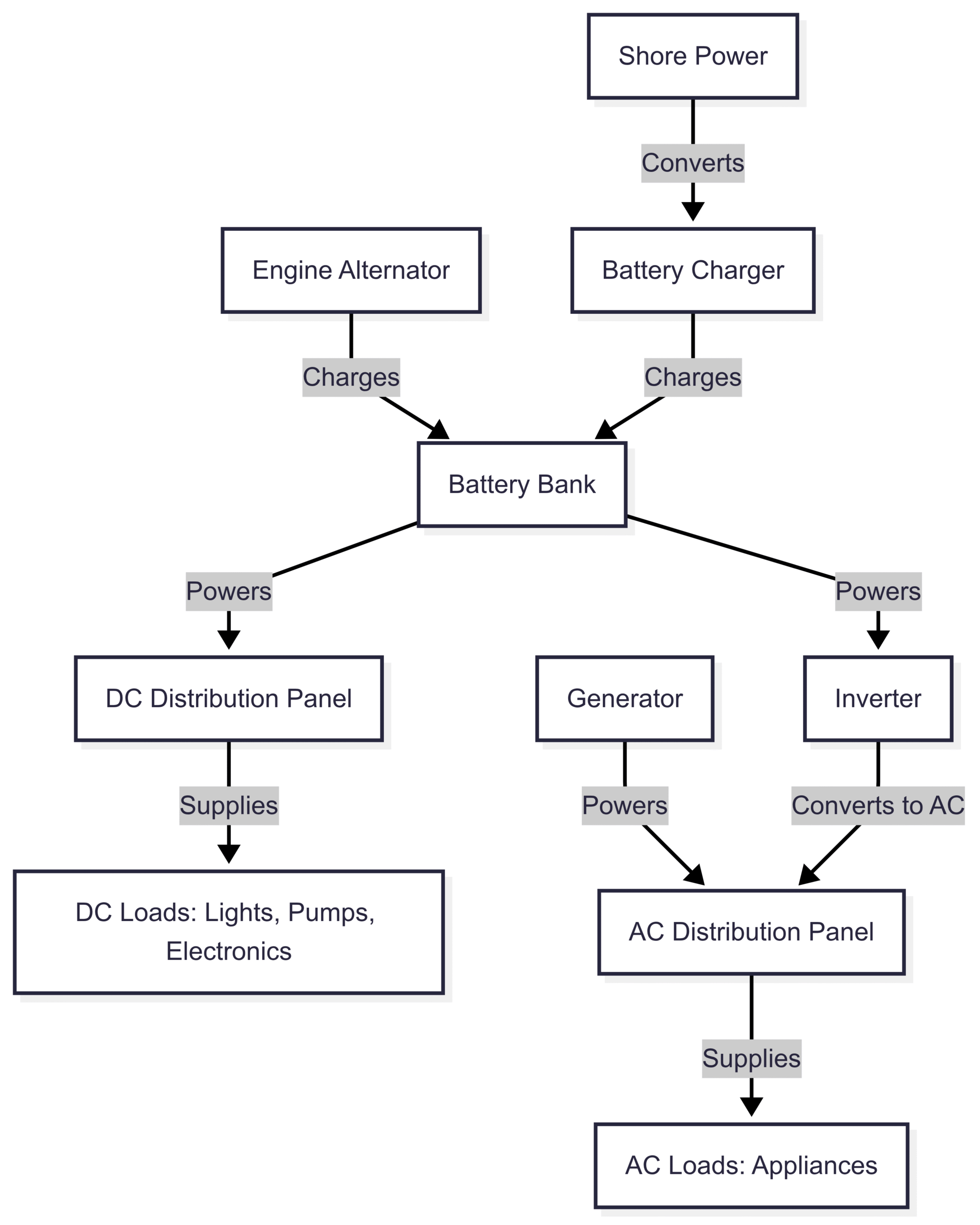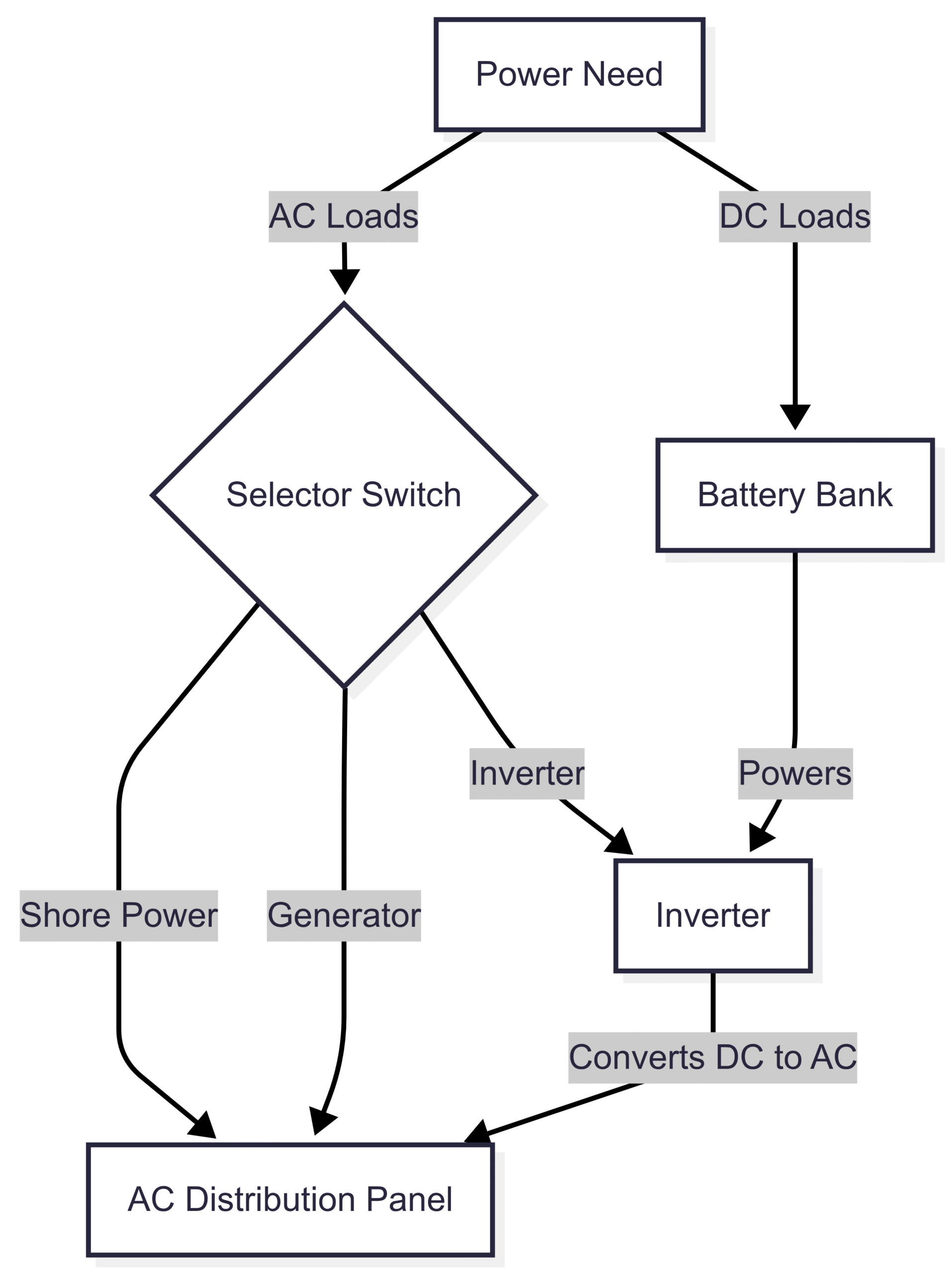Learn about your boat’s electrical system: components, maintenance, and safety tips for reliable marine power.
A boat’s electrical system is the backbone of its functionality, powering everything from navigation lights to engine starters and onboard appliances. Whether you’re a seasoned boater or new to marine adventures, understanding your vessel’s electrical system is essential for safe and reliable operation. This comprehensive guide explores the key components, best practices, safety considerations, and troubleshooting techniques for marine electrical systems, with a focus on practical insights for boat owners.
What is a Boat’s Electrical System?
Marine electrical systems primarily operate on direct current (DC), typically at 12 volts (12VDC), though some vessels, particularly those of foreign manufacture, may use 24VDC or 32VDC. For most recreational boaters, a 12VDC system is recommended due to its widespread compatibility and ease of maintenance. Systems using higher voltages require specialized knowledge and equipment, which can complicate repairs and upgrades for the average boater.
The electrical system integrates power generation, storage, and distribution to support critical boat functions, including lighting, navigation equipment, pumps, and entertainment systems. For vessels equipped with alternating current (AC) systems, additional components like inverters or generators enable the use of household appliances. Understanding how these systems interact ensures smooth operation and prevents costly failures.
Key Components of a Marine Electrical System
1. Power Generation
Boats rely on multiple sources to generate electricity:
- Alternators: Mounted on the engine, alternators recharge batteries while the engine runs, converting mechanical energy into electrical energy. Most alternators produce 12VDC to match the boat’s battery system.
- Generators: Larger vessels may include diesel or gasoline-powered generators to produce AC power, typically 120VAC or 240VAC, mimicking shore power for appliances like air conditioners or microwaves.
- Solar Panels: Increasingly popular for sustainable power, solar panels generate DC electricity to charge batteries, ideal for extended cruising or anchoring in remote areas.
- Wind Generators: Less common but useful for long-distance cruisers, wind generators supplement battery charging in windy conditions.
2. Batteries
Batteries are the heart of the electrical system, storing energy for use when the engine or generator is off. There are two primary battery types in marine applications:
- Starting Batteries: Designed for high bursts of power to crank engines, these batteries are not suited for prolonged discharge.
- Deep-Cycle Batteries: Used as house batteries, these are built for sustained power delivery to support lights, electronics, and appliances. Common types include lead-acid, AGM (Absorbent Glass Mat), and lithium-ion batteries.
Battery Specifications (Example Models):
| Battery Type | Voltage | Capacity (Ah) | Weight (lbs) | Price (USD) |
|---|---|---|---|---|
| Lead-Acid (Trojan) | 12V | 100 | 60 | $150–$200 |
| AGM (Optima) | 12V | 75 | 50 | $250–$300 |
| Lithium-Ion (Relion) | 12V | 100 | 30 | $800–$1000 |
Maintenance Tip: Regularly check battery terminals for corrosion and ensure secure connections. Test battery voltage and specific gravity (for lead-acid batteries) to monitor health.
3. AC and DC Power
Marine systems primarily use DC power, supplied by batteries, for most onboard equipment. However, larger boats may incorporate AC power for appliances requiring 120VAC or 240VAC. AC power sources include:
- Shore Power: When docked, boats connect to marina power supplies via shore power cables, typically providing 120VAC (60Hz in the U.S.) or 240VAC for larger appliances.
- Inverters: These devices convert 12VDC to 120VAC, allowing AC appliances to operate without a generator. Inverters are rated by wattage, with typical capacities ranging from 1000W to 3000W.
- Generators: Provide AC power underway or at anchor, matching shore power specifications.
Note: Foreign boats may be wired for 240VAC/50Hz, which is incompatible with U.S. 240VAC/60Hz systems. Avoid purchasing such vessels unless you’re prepared for costly rewiring.
4. Switchboards and Distribution Panels
Distribution panels act as the central hub for routing power to circuits. They house circuit breakers or fuses to protect wiring and equipment from overloads. Panels are divided into:
- DC Panels: Control power to lights, pumps, and electronics.
- AC Panels: Manage power to outlets and hardwired appliances.
Best Practice: Label all circuits clearly and ensure panels are accessible for troubleshooting.
5. Wiring and Connections
Marine-grade wiring is essential due to the harsh marine environment. Key features include:
- Tinned Copper: Resistant to corrosion, unlike standard copper wiring.
- Proper Sizing: Wire gauge must match current demands to prevent overheating. For example, a 10-gauge wire supports up to 30 amps for short runs.
- Overcurrent Protection: Fuses or circuit breakers prevent damage from short circuits or overloads.
Wiring Standards (American Boat and Yacht Council – ABYC):
| Wire Gauge (AWG) | Max Current (Amps) | Typical Use |
|---|---|---|
| 16 | 10 | Lighting, small pumps |
| 12 | 20 | Medium electronics |
| 10 | 30 | Large pumps, inverters |
6. Grounding and Bonding
Grounding and bonding prevent corrosion and electrical hazards:
- Grounding: Connects electrical systems to a common ground point to prevent shocks.
- Bonding: Links metal components to prevent galvanic corrosion caused by stray currents in saltwater.
Safety Devices:
- Galvanic Isolators: Block stray currents from shore power.
- Isolation Transformers: Provide complete electrical isolation for enhanced safety.
7. Inverters and Battery Chargers
- Inverters: Convert DC to AC, enabling the use of household appliances without a generator. Typical models include:
- Xantrex Freedom XC 2000: 2000W, $700–$800.
- Victron Phoenix 3000: 3000W, $1200–$1400.
- Battery Chargers: Convert AC shore power to DC to recharge batteries. Example: Promariner Pronautic 1240P, 40A, $400–$500.
Mermaid Chart: Basic Electrical System Flow

Best Practices for Maintenance and Operation
Maintaining a marine electrical system requires diligence to ensure reliability and safety in harsh conditions.
1. Regular Inspections
- Wiring: Check for fraying, chafing, or corrosion, especially at connections.
- Batteries: Inspect terminals for corrosion and test voltage (12.6V–12.8V for a fully charged 12V battery).
- Circuit Protection: Ensure fuses and breakers are functional and correctly rated.
2. Keep Components Clean and Dry
Corrosion is a primary enemy in marine environments. Use dielectric grease on connections and store batteries in sealed, ventilated compartments. Avoid water ingress in panels and wiring.
3. Proper Wiring Techniques
- Use marine-grade, tinned copper wiring.
- Secure wires with cable ties or clips to prevent chafing.
- Route wires away from heat sources and sharp edges.
4. Follow Manufacturer Guidelines
Adhere to maintenance schedules for batteries, chargers, and inverters. For example, lithium-ion batteries require specific chargers to prevent overcharging.
5. Environmental Considerations
Marine systems must withstand salt, humidity, and temperature extremes. Use IP-rated (e.g., IP65) enclosures for electronics and ensure proper ventilation to prevent overheating.
Safety Considerations
Electrical hazards on boats can lead to shocks, fires, or corrosion-related damage. Key safety practices include:
1. Overcurrent Protection
Install fuses or circuit breakers on all circuits. For example, a 1000W inverter requires a 100A fuse on the DC input side.
2. Proper Wiring Practices
- Use correct wire gauge to prevent overheating.
- Avoid makeshift repairs with non-marine-grade materials.
- Ensure proper insulation and chafe protection.
3. Safety Devices
- Galvanic Isolators: Prevent stray currents that cause corrosion. Example: Zinc Saver 30A, $150–$200.
- Isolation Transformers: Enhance safety for AC systems. Example: Victron Isolation Transformer 3600W, $700–$900.
4. Awareness of Hazards
- Shock Risk: Avoid working on live circuits, especially in wet conditions.
- Fire Risk: Overloaded circuits or poor connections can ignite flammable materials. Install smoke detectors near electrical panels.
Operating a Dual-Battery System
Many boats use a dual-battery setup with an engine battery for starting and a house battery for other loads. A battery selector switch manages these batteries:
- Position 1 (Engine Battery): Used to start the engine and power DC loads when running.
- Position 2 (House Battery): Powers lights, electronics, and appliances when the engine is off.
- Both: Connects both batteries to the alternator for charging while underway.
Operation Example:
- At anchor, switch to Position 2 to use the house battery.
- Before starting the engine, switch to Position 1 to preserve the house battery.
- Once underway, switch to “Both” to charge both batteries.
- At rest, return to Position 2 to avoid draining the engine battery.
This system ensures you always have a charged battery for starting, even if the house battery is depleted. Deep-cycle batteries are recommended for house use due to their ability to handle repeated discharges, while starting batteries should be standard lead-acid or AGM for high cranking power.
Advanced Systems: Generators and Inverters
Generators
Generators provide AC power for large appliances when away from shore power. Common specifications include:
- Honda EU2200i: 2200W, gasoline, $1100–$1300.
- Cummins Onan 5kW: 5000W, diesel, $4000–$5000.
Operation: Switch the AC selector to “Generator” when underway or at anchor. Generators are fuel-intensive, costing $1–$3 per hour depending on fuel type and load.
Inverters
Inverters allow AC appliance use without a generator, drawing power from the house battery. Key considerations:
- Capacity: Choose an inverter based on appliance wattage. For example, a 1500W microwave requires a 2000W inverter.
- Efficiency: Inverters lose 10–15% of power during conversion, so oversize slightly.
- Limitations: High-power appliances like air conditioners are impractical for inverters due to battery drain.
Mermaid Chart: Power Source Selection

Troubleshooting with a Digital Multimeter
A digital multimeter is indispensable for diagnosing electrical issues. Common tasks include:
- Checking Battery Voltage: A healthy 12V battery reads 12.6V–12.8V when fully charged.
- Testing Continuity: Ensure wiring and connections are intact.
- Measuring Current Draw: Identify parasitic loads draining batteries.
Example: To test a circuit, set the multimeter to DC voltage, connect probes to the circuit, and verify readings match expected values (e.g., 12V for a DC circuit).
Environmental and Cost Considerations
Environmental Factors
Marine electrical systems face unique challenges:
- Saltwater Corrosion: Use tinned wiring and sealed connectors.
- Temperature Extremes: Ensure components are rated for -20°F to 140°F.
- Vibration: Secure all components to withstand engine vibrations.
Cost Analysis
Maintaining an electrical system involves ongoing costs:
| Component | Initial Cost (USD) | Maintenance Cost (Annual, USD) |
|---|---|---|
| Deep-Cycle Battery | $150–$1000 | $50–$100 (testing, replacement) |
| Inverter (2000W) | $700–$1400 | $20–$50 (inspection) |
| Generator (5kW) | $4000–$5000 | $200–$500 (fuel, servicing) |
| Solar Panel (100W) | $100–$200 | $10–$20 (cleaning) |
Tip: Solar panels offer long-term savings for cruisers, reducing reliance on generators.
Conclusion
A boat’s electrical system is a complex but manageable network that powers essential functions. By understanding components like batteries, alternators, inverters, and generators, and following best practices for maintenance and safety, boaters can ensure reliable performance. Regular inspections, proper wiring, and adherence to safety standards minimize risks and extend system lifespan. Whether you’re cruising coastal waters or anchoring in a secluded bay, a well-maintained electrical system keeps your vessel running smoothly, letting you focus on the adventure ahead.
Share Getting to Know Your Boat’s Electrical System with your friends and Leave a comment below with your thoughts.
Read How to Restring a Fishing Reel for Beginners? Step-By-Step until we meet in the next article.

Clear and easy to understand! This post explains how boats get electricity in a simple way—perfect for someone new to boating. Learned something new without getting overwhelmed.